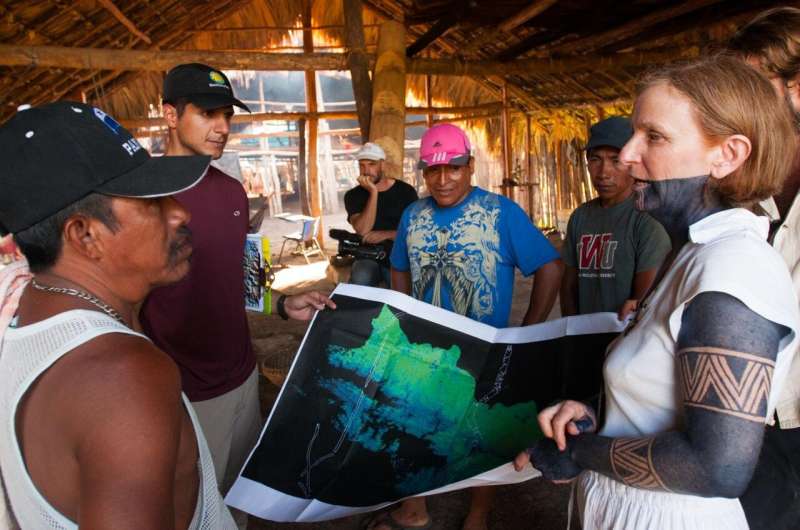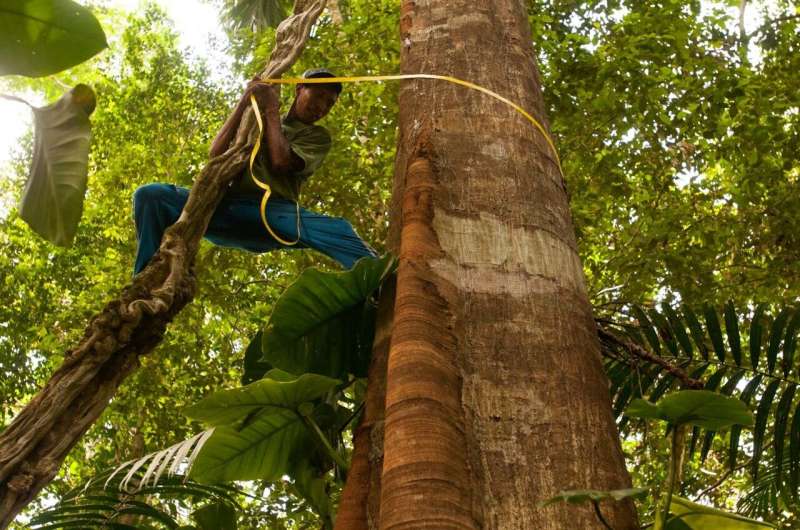A team of trained Embera and Wounaan Indigenous technicians tested a field-based forest carbon inventorying method in Darien's mature forests. Credit: Sean Mattson/Smithsonian Tropical Research Institute
Forests in Darien, an eastern province of Panama, are crucial for carbon storage, biodiversity conservation and the livelihoods of indigenous groups, yet they are under threat due to illegal logging. Through a participatory forest-carbon monitoring project, scientists from the Smithsonian Tropical Research Institute (STRI), McGill University and the National Research Council of Canada uncovered sources of above-ground biomass (AGB) variation and explored considerations for implementing Reducing Emissions from Deforestation and Forest Degradation (REDD+) in Darien.
"Indigenous authorities were interested in quantifying forest-carbon stocks using field-based measurements to validate the REDD+ potential of their forests and engage in informed discussions with REDD+ proponents in the country," said Javier Mateo-Vega, former research fellow at STRI and main author of the study.
As part of the study, the scientists and a team of trained indigenous technicians analyzed 30 one-hectare plots distributed across a large, mature forest landscape, in undisturbed and disturbed areas. They found that Darien has the highest carbon stocks among nine mature forest sites across the Neotropics, and the second-highest tree species richness among five mature forest sites in the region, supporting the need to protect it in a culturally appropriate way with the region's indigenous peoples.
"I have been working in Darien since 1993 and also perceived these forests as exceptional. It was very exciting when we analyzed the results to see just 'how' exceptional they really are," said Catherine Potvin, research associate at STRI and Canada Research Chair in Climate Change Mitigation and Tropical Forests at McGill University. "Hopefully our results will help give visibility to their global importance for carbon and for biodiversity."
Researchers found that the amount of carbon a forest stores is mainly affected by the selective extraction of large trees. Credit: Sean Mattson/Smithsonian Tropical Research Institute
They also discovered that, although half of the plots in the sample had experienced traditional indigenous extractive activities, satellite analyses of vegetation cover did not detect changes in canopy height or noticeable damage to the landscape like agriculture or cattle ranching would. In the field, however, disturbed plots harbored 54% less biomass than intact forests, so their AGB volumes differed vastly from those of undisturbed plots, but their structure and characteristics did not.
This led researchers to ascertain that the main determinant of AGB variation is the level of disturbance in the forest. That is, the amount of organic matter above the ground—in standing trees—and the amount of carbon it stores, is mainly affected by the selective extraction of large trees rather than by differences across forest types or any other factors.
The study also revealed that even when disturbed forests lost half of their carbon as compared to undisturbed ones, they maintained the same tree species richness. In addition, disturbed forests still maintained a disproportionately high capacity to sequester carbon, suggesting that they should not necessarily be excluded from REDD+ investments given its interest in targeting areas where climate-change mitigation and biodiversity conservation can be achieved simultaneously.
"Decades of efforts to protect Darien's natural and cultural heritage through different protected areas' management categories and land-tenure regimes for indigenous peoples are being stripped away by rampant illegal logging," Mateo-Vega said. "Our study conclusively demonstrates how important these forests are for climate-change mitigation, biodiversity conservation and the well-being of indigenous peoples."
More information: Tree aboveground biomass and species richness of the mature tropical forests of Darien, Panama, and their role in global climate change mitigation and biodiversity conservation, Conservation Science and Practice. DOI: 10.1111/csp2.42
Provided by Smithsonian Tropical Research Institute

























